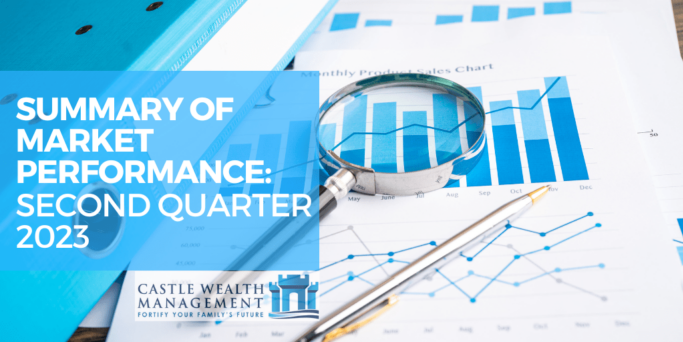U.S. EQUITY INVESTMENT ENVIRONMENT
U.S. equity markets performed well in the second quarter and year-to-date, as Congress approved legislation to suspend the debt ceiling and the Federal Reserve opted for a “hawkish pause” at their last meeting. The NASDAQ led major averages higher in Q2 with its gain of 13.1% as the now memorialized “magnificent seven” mega-cap growth stocks outperformed in response to continued enthusiasm over artificial intelligence. Despite a strong June performance, the Dow Jones Industrial Average continues to lag, up 4.9% on the year, while the S&P 500 returned 16.9%. In terms of relative valuation however, the NASDAQ P/E ratio of 31.2 has become much loftier than that of the S&P 500 at 19.7. The S&P 500’s information technology sector outperformed once again in the second quarter with a 17.2% gain and a remarkable 42.8% return on the year, led by Apple, Microsoft, and Nvidia. Consumer discretionary and communication services posted strong quarters as well, surging 33.1% and 36.2% in the first half of the year. In the second quarter, the S&P 500’s utilities sector experienced the steepest drop of 2.5%, while energy, the strongest sector of 2022, continued to underwhelm, returning a loss of 0.9%. Although smaller capitalization issues are lagging on a year-to-date basis, the S&P SmallCap 600 recovered an impressive 8.2% for June as concerns over regional banks have dissipated.
INTERNATIONAL EQUITY ENVIRONMENT
Foreign markets underperformed the U.S. with the MSCI EAFE index of developed markets up a modest 3.0% in the quarter and 11.7% year-to-date. Economic softness and persistent inflation led the central banks of Australia, Canada, the European Union, and UK to raise interest rates. Japan, the benchmark’s largest component and second-best performer, gained 6.4% for the recent quarter and 13.0% on the year. With inflation at 3.2%, the Bank of Japan stuck to its ultra-loose policy leaving rates unchanged. In contrast, the United Kingdom disappointed with a 2.2% quarterly return. With headline inflation at 8.7%, the Bank of England surprised markets by increasing rates by 50 bps in June. The European Central Bank raised by 25 bps. The MSCI Emerging Markets Index lagged with a 0.9% return led by China, which posted a significant loss of 9.7% for the second quarter as exports declined the most in three years. Similar to the U.S., information technology was the top-performing sector and silver lining, as positive sentiment around artificial intelligence has driven spectacular performance for some of the world’s largest semiconductor companies such as Taiwan Semiconductor Manufacturing and ASML.
FIXED INCOME ENVIRONMENT
The Bloomberg U.S. Aggregate Bond Index fell 0.8% in Q2 as the Federal Reserve announced one rate hike of 25bps in May, bringing the Federal Funds Rate to 5.0%-5.25%, the highest level since 2007, before pausing in June. U.S. Treasury yields across all maturities ended the quarter higher and the 1-year U.S. Treasury yield surpassed its recent March 2023 high, finishing the quarter yielding 5.40%. The 10-year U.S. Treasury yield rose from 3.47% to 3.81% while the 2-year U.S. Treasury yield climbed from 4.03% to 4.87%, marking a further inversion of the yield curve. In response to higher interest rates, long-dated maturities performed poorly while leveraged loans and high-yield bonds benefited as immediate recessionary concerns were pared back. The emerging market debt rally continued as the JPMorgan EMBI Global Index gained 1.5% for the quarter, bringing its year-to-date return up to 3.8%. The U.S. annual inflation number slowed more than expected last quarter, with the headline CPI number dropping from 4.9% in April, to 4.0% in May, and 3.0% in June, which is a significant improvement from the peak rate of 9.1% last June.
COMMODITIES ENVIRONMENT
The S&P GSCI Index dropped 2.7% in the second quarter and finished down 7.5% through the first half of the year. Industrial metals and energy were the worst-performing sectors with declines of 9.1% and 3.2%, respectively, as the recovery in China proved to be slower than anticipated. Precious metals also ended the quarter in negative territory with Gold and Silver retreating by 2.5% and 5.1%.

